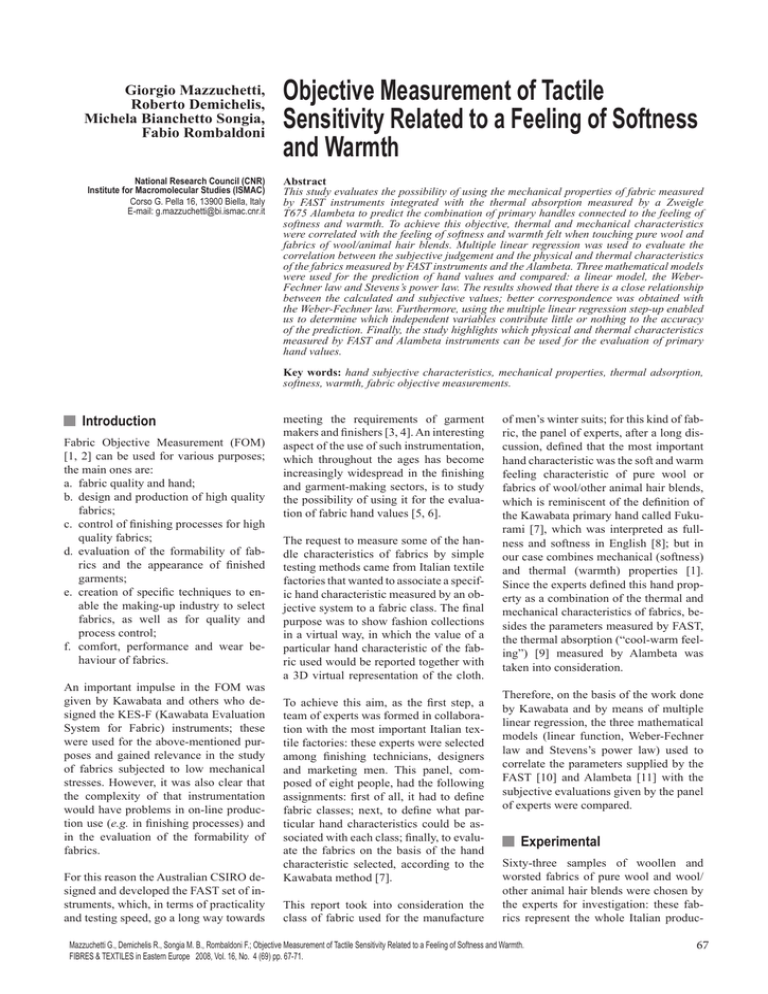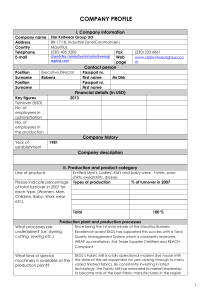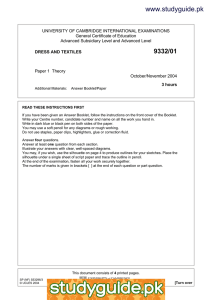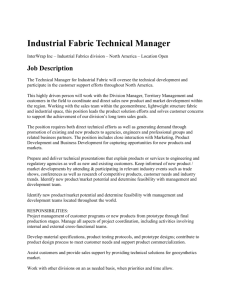n Introduction
advertisement

Giorgio Mazzuchetti, Roberto Demichelis, Michela Bianchetto Songia, Fabio Rombaldoni National Research Council (CNR) Institute for Macromolecular Studies (ISMAC) Corso G. Pella 16, 13900 Biella, Italy E-mail: g.mazzuchetti@bi.ismac.cnr.it Objective Measurement of Tactile Sensitivity Related to a Feeling of Softness and Warmth Abstract This study evaluates the possibility of using the mechanical properties of fabric measured by FAST instruments integrated with the thermal absorption measured by a Zweigle T675 Alambeta to predict the combination of primary handles connected to the feeling of softness and warmth. To achieve this objective, thermal and mechanical characteristics were correlated with the feeling of softness and warmth felt when touching pure wool and fabrics of wool/animal hair blends. Multiple linear regression was used to evaluate the correlation between the subjective judgement and the physical and thermal characteristics of the fabrics measured by FAST instruments and the Alambeta. Three mathematical models were used for the prediction of hand values and compared: a linear model, the WeberFechner law and Stevens’s power law. The results showed that there is a close relationship between the calculated and subjective values; better correspondence was obtained with the Weber-Fechner law. Furthermore, using the multiple linear regression step-up enabled us to determine which independent variables contribute little or nothing to the accuracy of the prediction. Finally, the study highlights which physical and thermal characteristics measured by FAST and Alambeta instruments can be used for the evaluation of primary hand values. Key words: hand subjective characteristics, mechanical properties, thermal adsorption, softness, warmth, fabric objective measurements. n Introduction Fabric Objective Measurement (FOM) [1, 2] can be used for various purposes; the main ones are: a. fabric quality and hand; b. design and production of high quality fabrics; c. control of finishing processes for high quality fabrics; d. evaluation of the formability of fabrics and the appearance of finished garments; e. creation of specific techniques to enable the making-up industry to select fabrics, as well as for quality and process control; f. comfort, performance and wear behaviour of fabrics. An important impulse in the FOM was given by Kawabata and others who designed the KES-F (Kawabata Evaluation System for Fabric) instruments; these were used for the above-mentioned purposes and gained relevance in the study of fabrics subjected to low mechanical stresses. However, it was also clear that the complexity of that instrumentation would have problems in on-line production use (e.g. in finishing processes) and in the evaluation of the formability of fabrics. For this reason the Australian CSIRO designed and developed the FAST set of instruments, which, in terms of practicality and testing speed, go a long way towards meeting the requirements of garment makers and finishers [3, 4]. An interesting aspect of the use of such instrumentation, which throughout the ages has become increasingly widespread in the finishing and garment-making sectors, is to study the possibility of using it for the evaluation of fabric hand values [5, 6]. The request to measure some of the handle characteristics of fabrics by simple testing methods came from Italian textile factories that wanted to associate a specific hand characteristic measured by an objective system to a fabric class. The final purpose was to show fashion collections in a virtual way, in which the value of a particular hand characteristic of the fabric used would be reported together with a 3D virtual representation of the cloth. To achieve this aim, as the first step, a team of experts was formed in collaboration with the most important Italian textile factories: these experts were selected among finishing technicians, designers and marketing men. This panel, composed of eight people, had the following assignments: first of all, it had to define fabric classes; next, to define what particular hand characteristics could be associated with each class; finally, to evaluate the fabrics on the basis of the hand characteristic selected, according to the Kawabata method [7]. This report took into consideration the class of fabric used for the manufacture of men’s winter suits; for this kind of fabric, the panel of experts, after a long discussion, defined that the most important hand characteristic was the soft and warm feeling characteristic of pure wool or fabrics of wool/other animal hair blends, which is reminiscent of the definition of the Kawabata primary hand called Fukurami [7], which was interpreted as fullness and softness in English [8]; but in our case combines mechanical (softness) and thermal (warmth) properties [1]. Since the experts defined this hand property as a combination of the thermal and mechanical characteristics of fabrics, besides the parameters measured by FAST, the thermal absorption (“cool-warm feeling”) [9] measured by Alambeta was taken into consideration. Therefore, on the basis of the work done by Kawabata and by means of multiple linear regression, the three mathematical models (linear function, Weber-Fechner law and Stevens’s power law) used to correlate the parameters supplied by the FAST [10] and Alambeta [11] with the subjective evaluations given by the panel of experts were compared. n Experimental Sixty-three samples of woollen and worsted fabrics of pure wool and wool/ other animal hair blends were chosen by the experts for investigation: these fabrics represent the whole Italian produc- Mazzuchetti G., Demichelis R., Songia M. B., Rombaldoni F.; Objective Measurement of Tactile Sensitivity Related to a Feeling of Softness and Warmth. FIBRES & TEXTILES in Eastern Europe 2008, Vol. 16, No. 4 (69) pp. 67-71. 67 tion of pure wool. and fabrics of wool/ other animal blends for the production of men’s suiting (Table 1). They were classified into seven groups with reference to the type of fibre and spinning system (worsted or woollen). As mentioned above, these fabric samples were evaluated by a panel of eight experts according to the definition given above. Each judge divided the fabric samples into 11 groups, from 0 to 10, following the method used by Kawabata and others for the standardisation of primary hands. The assessments of the judges were compared with each other using the bivariate correlation procedure, with the calculation of Spearman’s rank correlation coefficient rho [17]. Then the average values of the judgements for each sample were compared to the physical parameters of the fabrics measured using the FAST and Alambeta instruments by means of the following three equations: n Weber-Fechner law [12]: n y = k + ∑ ai log xi (1) i =1 n Stevens’s power law [13-16]: n log y = k + ∑ ai log xi (2) Table 1. Types of fabric. Raw material Spinning system Mass per square meter, g/m2 Number of samples 1 wool worsted from 138 to 275 35 2 wool/mohair worsted from 119 to 196 5 3 wool woollen from 187 to 331 6 4 wool/cashmere woollen from 193 to 235 5 5 cashmere woollen from 194 to 246 4 6 cashmere worsted from 186 to 214 4 7 alpaca worsted from 218 to 227 4 Group Table 2. Fabric properties measured using the FAST system. Stress Properties measured and calculated (*) n y = k + ∑ ai xi (3) i =1 where k and a are constants, xi is the ith value of independent variables n measured with the FAST and Alambeta instruments, and y is the tactile sensation (in our case the feeling of softness and warmth which one experiences when touching a fabric of winter animal fibres). The constants k and a were obtained by means of the multiple linear regression method. The linear function was chosen from several groups of workers to examine the relationship between the subjective and objective measurements of fabric handle [14, 19] as well as the Weber-Fechner law and Stevens’s power law [14]. In these three mathematical models, the subjectively evaluated attribute was related to the sum of the different contributions made by a number of objective measurements made using the FAST and Alambeta [1]. The physical parameters are listed in Table 2, while those calculated are shown in Table 3. 68 Unit Traction Bending Bending length Bending rigidity (*) Compression Thickness at 0.196 kPa Thickness at 9.81 kPa Thickness of surface layer (*) Shear Shear rigidity (*) G N/m Formability Formability (*) F mm2 E5 E20 E100 EB5 % % % % C B mm µNm T2 T100 ST mm mm mm Table 3. Expressions linking the measured and calculated properties. Calculated properties Expression Thickness of surface layer ST = T2 - T100 Shear rigidity G = 123 / EB5 Bending rigidity B = W x C3 x 9.81 x 10-6 where C = bending length in mm W = fabric weight in g/m2 Formability F = ((E20 - E5) x B) / 14.7 i =1 n Linear function: Symbol Extension to 4.9 N/m Extension to 19.6 N/m Extension to 98.1 N/m Bias extension For the experiment the following properties were used: extension to 98.1 N/m (E100), bending rigidity (B), shear rigidity (G), the thickness of the fabric subjected to a pressure of 9.81 kPa (T100), thickness of the surface layer (or surface thickness) (ST), mass per square meter (W) and formability (F). As regards the thermal properties, the thermal absorption (b), measured by the Alambeta, was taken into consideration. Its value is calculated by the following formula: b = λ × ρ × c in Ws1/2 m-2 K-1 (4) where: λ = thermal conductivity; ρ = fabric density; c = specific heat of the fabric. Thermal absorption is a surface property, typical of single-layer homogenous fabric, and allows to assess the fabric with reference to its “cool-warm feeling”. In Table 4 the mean and range (min and max) of the values of the properties di- rectly measured (E100, T100, W and b) and derived (B, G, ST and F) for each group of fabric are reported. n Results and discussion The procedure of bivariate correlation and calculation of the rank correlation coefficient (Spearman’s rho) was used to establish what degree of agreement existed between the experts when they evaluated the tactile sensation defined as: “the soft and warm feeling characteristic of pure wool or fabrics of wool/other animal hair blends”. In Table 5 [17, 18] the rank correlation coefficients for each of the seven pairs of experts are reported. This coefficient can range in samples from –1 (complete discordance) to +1 (complete concordance) [18]. The results highlight that all the correlations between the assessments of the experts are significant at a level of 1%, and therefore there is an important and remarkable uniformity of judgement among the experts: the best accordFIBRES & TEXTILES in Eastern Europe 2008, Vol. 16, No. 4 (69) Table 4. Mean, minimum and maximum values of the properties. Fabric group E100 B G T100 ST W F b Mean Min Max Mean Min Max Mean Min Max Mean Min Max Mean Min Max Mean Min Max Mean Min Max 3.91 1.65 9.05 2.66 2.25 2.85 4.31 3.20 6.75 6.37 3.43 8.05 5.99 5.35 6.85 3.19 2.00 4.05 2.90 2.40 3.20 7.37 4.10 18.55 5.48 3.65 6.55 15.18 4.70 28.70 7.67 5.50 9.90 7.99 5.00 12.45 5.44 4.40 6.90 10.70 10.20 11.40 27.34 13.00 59.00 27.60 24.00 32.00 35.00 19.00 53.00 18.00 15.00 23.00 18.00 13.00 24.00 16.75 15.00 19.00 16.25 15.00 18.00 0.422 0.261 0.788 0.329 0.235 0.449 0.826 0.482 1.295 0.646 0.601 0.731 0.761 0.539 1.097 0.408 0.348 0.469 0.495 0.445 0.539 0.100 0.052 0.206 0.069 0.049 0.126 0.243 0.136 0.463 0.285 0.195 0.386 0.483 0.191 1.098 0.142 0.105 0.201 0.195 0.136 0.234 199.1 138.0 275.0 158.2 119.0 196.0 273.8 187.0 331.0 220.2 193.0 235.0 219.5 194.0 246.0 198.0 186.0 214.0 222.8 218.0 227.0 0.46 0.17 1.29 0.32 0.18 0.66 1.20 0.36 2.53 0.97 0.82 1.22 0.94 0.54 1.42 0.32 0.17 0.41 0.53 0.45 0.65 114.15 83.72 133.22 110.72 106.35 118.79 86.72 73.58 99.92 78.68 66.85 89.30 69.14 54.68 77.84 108.71 103.87 119.24 97.14 87.98 107.16 1 2 3 4 5 6 7 Table 5. Spearman’s correlation coefficient - rho; * correlation significant at a level of 0.01 (2-code). Expert 1 2 3 4 5 6 7 8 1 1.000 0.940* 0.921* 0.914* 0.915* 0.913* 0.908* 0.900* 2 0.940* 1.000 0.844* 0.878* 0.851* 0.858* 0.899* 0.877* 3 0.921* 0.844* 1.000 0.887* 0.907* 0.876* 0.851* 0.815* 4 0.914* 0.878* 0.887* 1.000 0.919* 0.905* 0.883* 0.871* 5 0.915* 0.851* 0.907* 0.919* 1.000 0.913* 0.867* 0.841* 6 0.913* 0.858* 0.876* 0.905* 0.913* 1.00 0.893* 0.893* 7 0.908* 0.899* 0.851* 0.883* 0.867* 0.893* 1.000 0.901* 8 0.900* 0.877* 0.815* 0.871* 0.841* 0.893* 0.901* 1.000* Table 6. Values of the Constants. Weber-Fechner law Physical Constants parameters k -51.898 Stevens’s power law Physical Constants parameters Linear function Physical Constants parameters k -6.391 k 11.024 Log E 6.208 Log E 0.979 E 0.106 Log B -5.656 Log B -0.317 B -0.287 Log G -3.806 Log G -0.44 G -0.065 Log T100 -23.824 Log T100 -2.145 T100 -14.351 Log ST 9.704 Log ST 1.148 ST Log W 40.39 Log W 3.626 W 0.064 Log F -7.472 Log F -1.066 F -1.097 Log b -15.604 Log b -0.519 b -0.093 0.870 Multiple correlation coefficient r 0.850 Multiple correlation coefficient r 0.922 Multiple correlation coefficient r ance is between expert 1 and 2 (Spearman’s rho = 0.940), while the worst one is between experts 3 and 8 (Spearman’s rho = 0.815). These results also show that the definition of tactile sensation agreed upon is clear, univocal and does not allow different interpretations. Average values of the judgements for each fabric sample were calculated and introduced in the three different equations (1), (2) and (3). The values of the constants were calculated by multiple block regression with the help of SPSS 10 statistical comFIBRES & TEXTILES in Eastern Europe 2008, Vol. 16, No. 4 (69) 9.926 puter program: in this case all physical parameter values (independent variables) are included [17, 18]. In Table 6 values of the constants and multiple linear regression coefficients for each of the three different mathematical models are reported. Comparison between the proposed equations gave the following results: n Weber-Fechner law multiple correlation coefficient r = 0.922 n Stevens’s power law multiple correlation coefficient r = 0.870 n Linear function multiple correlation coefficient r = 0.850. The comparison between the multiple correlation coefficients shows that the better equation for evaluating the tactile sensation defined above is the WeberFechner law: its r is nearer to 1 than those of the other two equations. In Figure 1 (see page 70), for the sixtythree fabrics examined, the values calculated using the three equations are plotted along the x axis, while the subjective values are plotted along the y axis (average of the single subjective values), and Figure 2 (see page 70) shows a very good correlation between the subjective values and those calculated by the Weber-Fechner law. Of course this correlation does not imply cause and effect, but the properties most heavily correlated with the subjective feeling selected were identified in the statistics, which suggests that these properties are related to it [1]. On the other hand, it can be pointed out that it is not surprising that the important properties identified (bending, surface thickness, shear rigidity, thermal adsorption, etc.) are closely related to “softness and warmth” [1]. The multiple regression applied to the Weber-Fechner law was obtained by a method called ‘block regression’, which calculates the regression for all n variables. In effect it should seem to be more appropriate initially to use all the objective measurements in order to establish a correlation between the subjective feeling selected for the specific class of fabric taken into consideration and objective data before rejecting measurements that either do not make a significant contribution or are redundant [1]. However, it’s very important to also know which variables contribute little or nothing to the accuracy of the prediction. To achieve this aim, the step-up method (or forward selection) was used: this method allows to evaluate the contribution of each independent variable to the regression model. The variables are fitted in the model in a sequential way: the first independent variable selected x1 is that which gives the smallest residual mean square. One proviso is that F (F test) must exceed the boundary value chosen. In this case a 5% 69 Figure 2. Weber-Fechner law. Figure 1. Comparative distributions. significance level was used. Next, all the n-1 bivariate regressions in which x1 appears are evaluated. The variable selected gives the greatest additional reduction in the sum of squares after fitting x1 . The process stops when no unselected xi gives an F exceeding the boundary [17, 18]. In Table 7 the results obtained with the step-up method that was applied to the Weber Fechner law are summarised. The first variable which makes the greatest contribution to the prediction of the tactile sensation chosen by experts is the surface thickness ST (model 1), the second variable is the bending rigidity B (model 2), and so on until the last variable; the extension to 98.1 N/m E100 (model 8), which is an independent variable, has the least effect . The results show that the block of the first four variables- surface thickness ST, bending rigidity B, thermal absorption b and shear rigidity G (model 4) - contributes mainly to the accuracy of prediction of the tactile sensation chosen. In fact the multiple correlation coefficient value (r) of this block of variables is 0.847. Leaving aside model 1, the bending rigidity B (model 2) improves the r by 38%, the thermal absorption b by 5.4% (model 3) and the shear rigidity G by 3.3%. The remaining four variables only marginally help to improve it: in this case the increasing in r for models 4 and 8, in which all the independent variables are taken into consideration, is equal to 8%. The results obtained also confirm the conclusions of previous reports in which the mechanical parameters ST, B, G and warm feeling are closely related to fabric softness [1 - 8]. n Conclusions The study has shown that FAST and ALAMBETA instruments could help the evaluation of handle characteristics. In this way it was possible to answer to the specific request of the Italian textile factories that wanted to associate a fabric class with a specific handle characteristic measured using an objective system. Table 7. Statistical parameters of the step-up method or forward selection. Weber-Fechner law Model n y = k + ∑ ai log xi Residual mean square Standard error of estimate 1 constant: Log ST 0.561 3.860 1.9648 2 constant: Log ST, Log B 0.778 2.261 1.5038 3 constant: Log ST, Log B, Log b 0.820 1.914 1.3834 4 constant: Log ST, Log B, Log b, Log G 0.847 1.674 1.4441 5 constant: Log ST, Log B, Log b, Log G, Log W 0.858 1.589 1.2607 6 constant: Log ST, Log B, Log b, Log G, Log W, Log T100 0.899 1.173 1.0830 7 constant: Log ST, Log B, Log b, Log G, Log W, Log T100, Log F constant:, Log ST, Log B, Log b, Log G, Log W, Log T100, Log F, Log E100 0.907 1.107 1.0523 0.922 0.959 0.9792 8 70 Finally, in this particular case it is possible to use only these four parameters to accurately predict the tactile sensation chosen. Acknowledgment r i =1 The two instruments are easy to use and the test time is short. This permits their use not only in research laboratories but in factories too. In this work a maximum of eight independent variables (model 8) were taken into consideration to predict the tactile sensation chosen. The WeberFechner law, in particular, gives very good correspondence between the values calculated and the judgement of experts. Moreover, it has been demonstrated that the independent variables which mainly influence the subjective feeling selected, called “the soft and warm feeling characteristic of pure wool or fabric of wool/ other animal hair blends”, are the surface thickness ST, bending rigidity B, thermal absorption b and shear rigidity G. The close relation found between these physical properties of fabrics and their “softness and warmth” confirms the results obtained in previous articles. The authors wish to thank Dr. Alan De Boos of Australian Wool Innovation for his suggestions and comments. References 1. Bishop D.P.; Fabrics: sensory and mechanical properties, Textile Progress, 1996, 26 (3), pp. 1-64. 2. Postle R.; Fabric Objective Measurement Technology: 1, Historical and Background Development, Textile Asia, 1989, 20 (7), pp. 64-66. FIBRES & TEXTILES in Eastern Europe 2008, Vol. 16, No. 4 (69) 3. De Boos A., Tester D.; SiroFAST Fabric Assurance by Simple Testing, CSIRO Textile and Fibre Technology, Report No WT92.02, 1994, pp. 1-35. 4. Ly N. G., Tester D. H., Buckenham P., Roczniok A. F., Adriaansen A. L., Scaysbrook F., De Jong S.; Simple Instruments for Quality Control by Finishers and Tailors, Textile Research Journal, 1991, 61 (7), pp. 402-406. 5. De Boos A.; Finishing and Wool Fabric Properties - A Guide to the Theory and Practice of Finishing Woven Wool Fabrics - Chapter 2 - The objective measurement of finished fabric, CSIRO Wool Technology, 1997, pp. 44-56. 6. Mazzuchetti G., Demichelis R.; FAST system using evaluating a primary hand values feeling related to a crisp and cool fabric, The 10th International Wool Textile Research Conference, Aachen (Germany), 2000, FA-8. 7. Kawabata S., Niwa M.; Fabric performance in clothing and clothing manufacture, Journal of the Textile Institute, 1989, 80 (1), pp. 19-50. 8. Li Y.; The Science of Clothing Comfort, Textile Progress, 2001, 31 (1/2), pp. 1-135. 9. Frydrych I., Dziworska G., BilskaJ.; Comparative Analysis of the Thermal Insulation Properties of Fabrics Made of Natural and Man-Made Cellulose Fibres, Fibres & Textiles in Eastern Europe, 2002, 39, pp. 40-44. 10. FAST Instruction Manual, CSIRO, Australia. 11. T 675 Operating Instructions, ZWEIGLE, Germany. 12. Matsuo T., Nasu N., Saito M.; Study on the Hand - Part 2: The Method for Measuring Hand, Journal of the Textile Machinery Society of Japan, 1971, 17(3), pp. 92-104. 13. Stevens S. S.; On the psychophysical law, Psychological Review, 1957, 64 (3), pp. 153-181. 14. Hu J., Chen W., Newton A.; A psychophysical model for objective fabric hand evaluation: an application of Steven’s law, Journal of the Textile Institute, 1993, 84 (3), pp. 354-363. 15. Elder H. M., Fisher S., Armstrong K., Hutchison G.; Fabric softness, handle, and compression, Journal of the Textile Institute, 1984, 75 (1), pp. 37-46. 16. Elder H. M., Fisher S., Armstrong K., Hutchison G.; Fabric Stiffness, Handle and Flexion, Journal of the Textile Institute, 1984, 75 (2), pp. 99-106. 17. SPSS BASE 10.0. 18. Snedecor G. W., Cochran W. G.; Statistical Methods, Eighth Edition, Iowa State University Press, 1989. 19. Jeurissen P. C. J.; Looking for a Relation between Sensory and Instrumental Data, Final report of the postgraduate programme Mathematics for Industry, Technische Universiteit Eindhoven, the Netherlands, 1991, ISBN 90-5282-118-6 bound. Received 06.03.2007 Institute of Biopolymers and Chemical Fibres Instytut Biopolimerów i Włókien Chemicznych IBWCh Director of the Institute: Danuta Ciechańska Ph.D., Eng. The research subject of IBWCH is conducting scientific and development research of techniques and technologies of manufacturing, processing, and application, into in the following fields: n biopolymers, n chemical fibres and other polymer materials and related products, n pulp and paper industry and related branches R&D activity includes the following positions, among others: n biopolymers, n functional, thermoplastic polymers, n biodegradable polymers and products from recovered wastes, n biomaterials for medicine, agriculture, and technique, n nano-technologies, e.g. nano-fibres, and fibres with nano-additives, n processing of fibres, films, micro-, and nano- fibrous forms, and nonwovens, n paper techniques, new raw material sources for manufacturing paper pulps, n environmental protection, The Institute is active in inplementig its works in the textile industry, medicine, agriculture, as well as in the cellulose, and paper industries. The Institute is equipped with unique technological equipment, as the technological line for fibre (e.g. cellulose, chitosan, starch, and alginate) spinning by the wet method. The Institute organises educational courses and workshops in fields related to its activity. The Institute’s offer of specific services is wide and differentiated, and includes: n physical, chemical and biochemical investigations of biopolymers and synthetic polymers, n physical, including mechanical investigation of fibres, threads, textiles, and medical products, n tests of antibacterial and antifungal activity of fibres and textiles, n investigation in biodegradation, n investigation of morphological structures by SEM and ESEM n investigation and quality estimation of fibrous pulps, card boards, and paper products, including paper dedicated to contact with food, UE 94/62/EC tests, among others. n Certification of paper products. The Institute is active in international cooperation with a number of corporation, associations, universities, research & development institutes and centres, and companies. The Institute is publisher of the scientific journal ‘Fibres and Textiles in Eastern Europe’. Instytut Biopolimerów i Włókien Chemicznych (IBWCh) Institute of Biopolymers and Chemical Fibres ul. Skłodowskiej-Curie 19/27; 90-570 Łódź, Poland Phone: (48-42) 638-03-02, Fax: (48-42) 637-65-01 E-mail: ibwch@ibwch.lodz.pl http://www.ibwch.lodz.pl Reviewed 06.10.2007 FIBRES & TEXTILES in Eastern Europe 2008, Vol. 16, No. 4 (69) 71





